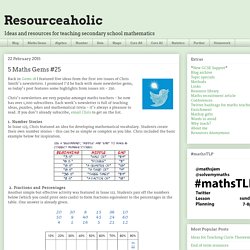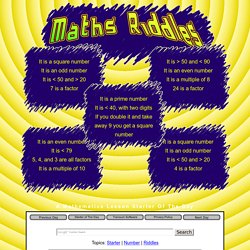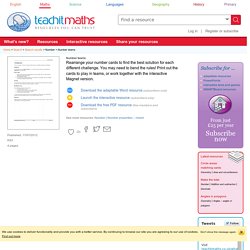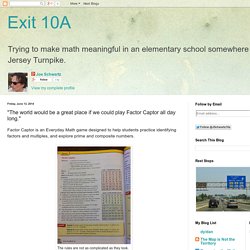

Pi Approximation Using Factors Activities. Hello and welcome to my 34th gems post.

This is where I share five teaching ideas I've seen on Twitter. The summer holidays are finally here! Let's be honest though - although it's lovely to have the opportunity to rest and play, the majority of us do a fair amount of school work over summer - creating resources, organising and tidying, preparing for September, catching up on reading... Have you read all 34 of my gems posts? Now's a good time to start! 1. 2. I love this prime clock from the brilliant Minimal Math Concepts. Whilst on the subject of primes, check out this excellent primes and factors puzzle from @LearningMaths: @LearningMaths always produces excellent resources. If you want to take this idea further, your class could design and produce a maths alphabet poster like the examples shown below. 4. 5. Recommended Reading This summer @DrBennison and @MissNorledge are undertaking an impressive #summerblogchallenge.
Here's a few recent posts that I recommend: Update. Hello and welcome to my 31st gems post.

This is where I share some of the best teaching ideas I've seen on Twitter. 1. Ratio tables The new GCSE is going to have an increased focus on proportional reasoning. I enjoyed @MissNorledge's post about using ratio tables for non-calculator conversions. It's a logical way to structure thinking. Miss Norledge helpfully provides a 'Master the Basics' worksheet on ratio tables.
This approach can be used for any kind of conversion. 2. 3. I really like the look of Alexander Cameron's (@AlexandeCameron) diagnostic assessments. For more information about Alexander's assessments see his TeachMeet presentation. 4. 5. Thank you to @MrPontinMaths for sharing this and an associated worksheet - 'The Hot Dog Buns Dilemma'. Update If you haven't seen my Pret homework website then do have a look.
Back in Gems 18 I featured five ideas from the first 100 issues of Chris Smith's newsletters.

I promised I'd be back with more newsletter gems, so today's post features some highlights from issues 101 - 250. Chris's newsletters are very popular amongst maths teachers - he now has over 1,000 subscribers. Each week's newsletter is full of teaching ideas, puzzles, jokes and mathematical trivia - it's always a pleasure to read. If you don't already subscribe, email Chris to get on the list. Maths Riddles. Topics: Starter | Number | Riddles How did you use this starter?

Can you suggest how teachers could present or develop this resource? Do you have any comments? It is always useful to receive feedback and helps make this free resource even more useful for Maths teachers anywhere in the world.Click here to enter your comments. If you don't have the time to provide feedback we'd really appreciate it if you could give this page a score! Excellent, I would like to see more like this Good, achieved the results I required Satisfactory Didn't really capture the interest of the students Not for me! This starter has scored a mean of 3.8 out of 5 based on 281 votes. FactorsMultiplesHolder. Number teams - Number - Number properties – mixed - Starters and plenaries - Search results - Search. Published: 17/07/2012KS3 4 pages Number teams Rearrange your number cards to find the best solution for each different challenge.

You may need to bend the rules! Print out the cards to play in teams, or work together with the interactive Magnet version. Download the adaptable Word resource (subscribers only) Launch the interactive resource Download the free PDF resource (free members and subscribers) See more resources: Number | Number properties – mixed Log in to love this resource Log in to share this resource Subscribe for ... From just £25 per year Subscribe now Latest resources Circle areas matching cardsGeometry | Area and circumference Make the totalNumber | Addition and subtraction | Decimals Angles in polygonsGeometry | Angles – angles in polygons.
Exit 10A: "The world would be a great place if we could play Factor Captor all day long." Factor Captor is an Everyday Math game designed to help students practice identifying factors and multiples, and explore prime and composite numbers.

We introduced the game to the fourth graders in October, at the beginning of our first multiplication unit. It took a few days, but eventually the kids got the hang of it. We encouraged them to use multiplication tables to find factors, and made a solemn vow not to use the words prime or composite. We just let them play and hoped that at some point they would come to the realization that some of the numbers had more factors than others. One day, about a week after we had introduced the game, I was walking around the room with my ipad and decided to record some kids playing a round. ...can you recreate the score sheet?
By this time the unit was nearing its conclusion, the assessment was just days away, we still hadn't introduced the terms prime and composite, and Jeff was starting to panic.